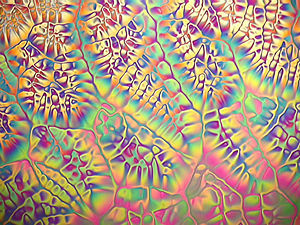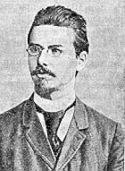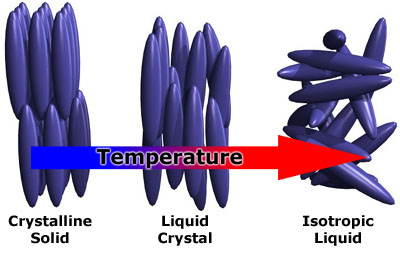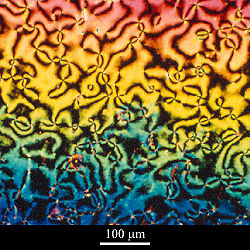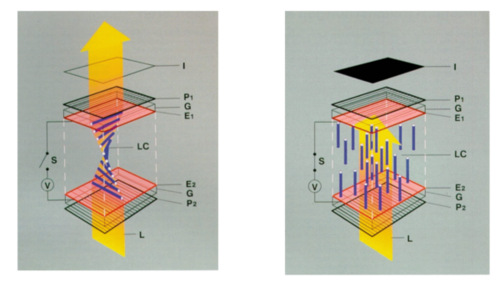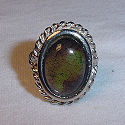Liquid Crystal: Difference between revisions
MatthewHoza (talk | contribs) |
MatthewHoza (talk | contribs) |
||
| Line 124: | Line 124: | ||
==References== | ==References== | ||
Chandrasekhar, ''Liquid Crystals'', 1977 | |||
Chigrinov, ''Liquid Crystal Devices: Physics and Applications'', 1999 | |||
Jones, ''Soft Condensed Matter'' | [1]Collings, ''Liquid Crystals'', 1990 | ||
Jones, ''Soft Condensed Matter'', 2002 | |||
[2]Kumar, ''Liquid Crystals'', 2001 | [2]Kumar, ''Liquid Crystals'', 2001 | ||
Saeva, ''Liquid Crystals: The Fourth State of Matter'', 1979 | |||
Takaki, ''A Novel 3D Display Using an Array of LCD Panels'', 2003 | |||
==External Links== | ==External Links== | ||
* [http://www.lci.kent.edu/ Liquid Crystal Institute at Kent State University] | * [http://www.lci.kent.edu/ Liquid Crystal Institute at Kent State University] | ||
Revision as of 17:21, 19 April 2009
Discovered more than 100 years ago, liquid crystals still remain an area of research today.
History
Many scientists had already observed this phenomenon of liquid crystals prior to its "discovery", however the Austrian botanist Friedrich Reinitzer is more often then not given credit for its discovery. While experimenting with cholesterol benzoate in 1888, Reinitzer noted that it the substance had two melting points. The first melting point occurred at 145.5°C, where it melted to a cloudy liquid phase, and 178.5°C, where it melted to a clear liquid phase. He also observed some strange color phenomena as the temperature changed.
Reinitzer then sent some of his samples to a German physicist, Otto Lehmann, who had a state of the art polarized microscopic, which he outfitted with heating stage so he could precisely control the temperature of his specimens. Lehmann first described Reinitzer's sample as floating crystals and crystalline fluids, but after more experimentation became convinced that the cloudy liquid was a uniform phase all its own. This led him to coin the term liquid crystal to describe this new phase of matter.
In the early 1900s, many advances were made in the understanding liquid crystals. In 1922, French physicist, Georges Freidel, gave a detailed description of different liquid crystal phases, coining many terms that are still used today. Freidel also explored the orienting effect of an electric field on liquid crystals.
After World War II interest in liquid crystals began to wane. Many scientists believed that all of the important problems regarding liquid crystals had been solved. However, in the 1960s scientists began to re-examine liquid crystals and continued the progress of the pre-war era. It was discovered that liquid crystalline substances were extremely sensitive to very small changes in temperature. Researchers at RCA found that with an electrical voltage applied, a thin layer of liquid crystal was capable of switching from cloudy to clear.
Overview
- Insert Chart Collings pg. 11
Solids possess both positional order, where molecules are constrained to occupy only certain positions, and orientaitional order, where each molecule is oriented with respect to one another. When a material transitions to a liquid both the positional and orientational order are lost, and the material becomes isotropic, or uniform in all directions. In the liquid crystal phase, molecules, or mesogen, display a wide range of positional and orientational orders, leading to several subphases. These subphases are defined by the amount of order present in the liquid crystal.
Liquid crystals are a phase of matter between the solid phase and the liquid phase. If you have a material that has a liquid crystal phase you would observe the two melting points that Reinitzer observed, one from the solid to liquid crystal transition and the second from the liquid crystal to isotropic liquid transition.
Some molecules are more likely to posses a liquid crystal phase than others. There are 3 properties that make a molecule a good candidate to become liquid crystal[1]:
(1) Elongated in shape: elongated molecules have stronger attractive forces when they are aligned parallel to one another.
(2) Rigid in the center:
(3) Flexible on the ends: allows for easier positioning in between other molecules
However, this is merely the most common shape, others do exist.
Since the liquid crystal phase is between that of solid and liquid, it displays characteristics common to both, as well as some unique characteristic all its own. Molecules are free to move about as in a liquid, however they on average spend more time pointing along the direction of orientation. Liquid crystal will also flow and take the shape of its container, however it also display a cloudiness which suggests that it is different from the liquid phase. Many unique characteristics of liquid crystals stem from the fact that it is an anisotropic phase. This means that the properties of the material are dependent on the direction that it is oriented in.
Methods to Measure Orientational Order
To quantitatively describe the amount of orientational order present in a subphase of liquid crystal the average direction of the mesogen, is measured with respect to a direction of orientation known as the director. Each molecule makes an angle, with respect to the director. This angle is then measured and averaged over all molecules.
The more orientational order present the closer the average will be to zero. An alternative way to do this is to take the average angle of one molecule over a certain time, instead of looking at different molecule. However, this only works under the assumption that all molecules undergo random motion. Thankfully, this assumption has never been contradicted experimentally.
To create a more standard method of measuring orientational order we introduce the order parameter . Where once again we take the angle with respect to the director, however this time we use the function,
Now integrating over the solid angle,
where is the fraction of molecules in a solid angle which are oriented at an angle of to the director.
Now perfect oriental orientation will have an average of 1 and no orientational order will have an average of 0.
Subphases
Thermotropic Subphases
The most common subphases in liquid crystal material are thermotropic, meaning that the ordering is determined by temperature.
- Isotropic: Identical in all directions
- The different phases have different amounts of positional and orientational order
Nematic
Nematic Phse can be thought of as a liquid that has long range orientational order, but lacks postional order.[2]
Smectic
Positionally ordered in 1D and orientational order
Columnar
(discotic): Positional order in 2D and orientational order
Lyotropic Subphases
- Latent Heat shows that liquid crystal is closer to a liquid than it is to a solid.
Applications
- Many common liquids are liquid crystals (i.e. soap)
External Electrical Field
- LC tend to line up parallel to an external E-Field
Displays
- Televisions (LCDs out, LEDs in)
- Anisotropic ... This characteristic means that LC can be turned transparent. Letting light pass through a series of polarizers. Combing this with the ability for LC to become transparent lets you display images by blocking out light. Used in early displays (calculators). Televisions essentially work the same way except they use color filters for RGB colors.
Thermometer
- Mood Ring
Continuing Research
Takaki: 3D Display
A Novel 3D Display Using an Array of LCD Panels (2003), Yasuhiro Takaki, Tokyo University
Insert Figure 6
- No need for 3D Glasses
- No restriction on observing position
- No fatigue
Electronic Paper
References
Chandrasekhar, Liquid Crystals, 1977
Chigrinov, Liquid Crystal Devices: Physics and Applications, 1999
[1]Collings, Liquid Crystals, 1990
Jones, Soft Condensed Matter, 2002
[2]Kumar, Liquid Crystals, 2001
Saeva, Liquid Crystals: The Fourth State of Matter, 1979
Takaki, A Novel 3D Display Using an Array of LCD Panels, 2003
